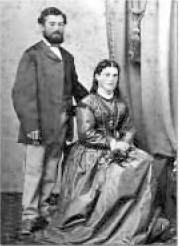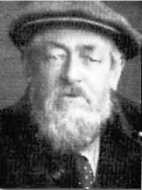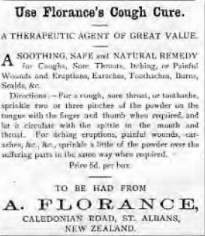Augustus Florance, 1847 - 1897

Augustus Florance senior and wife Elizabeth, about 1870
Born at Portland, Dorset, on 28 May 1847, Augustus Florance was the son of Jane Angell Stone and her husband, also Augustus, a doctor. Dr Florance, a “cribbage… [and] chess player, a man interested in natural philosophy, a reader of Shakespeare… Cervantes… [and] Desiderus Erasmus”, was a social reformer, endeavouring to accomplish the Sisyphean task of bringing temperance to the delinquents of Portland
.
Augustus junior and his contemporaries inherited this antipathy to the drink trade. A cousin, who emigrated to the USA, wrote, in 1886: I hope he (Augustus junior) adheres to his temperance sympathies. Tell him he has all my sympathy on that question. I belong to the Women’s Christian Temperance Union… We all hope and pray that the curse of strong drink will be removed from our republic, which will come in God’s own time
.
When his wife died, Dr Florance left his family in the care of relatives and sailed for New Zealand. He lived at the Hutt, near Wellington, produced “primitive” paintings of the area (now held in the Alexander Turnbull Library), married a second time, went back to England and emigrated to Lyttelton as ship’s doctor on the Mersey in 1862.
Dr and Mrs Florance settled in St Albans, Christchurch, the narrow blind lane up to their home being where Ranfurly Street now runs off Caledonian Road. The doctor, a popular general practitioner, dressed in silk dust coat and top hat, cultivated medicinal herbs, supported the Total Abstinence and St Albans Mutual Improvement societies, and died in 1879, a poor man with an honoured name
. His widow, Elizabeth, lived on at the property till her death, at 91, in 1906.
In England, Augustus junior dwelt in a loving Christian environment. The cousin who settled in America noted: I used to get Gussie to sleep many a time in Portland
. Augustus himself wrote that, at 10, he was converted to know and believe in Jesus Christ, the Son of God, by earnestly reading the New Testament at school…
. He emigrated to Canterbury on the Captain Cook, arriving in September 1863. Although he was assisted by the provincial government, Dr Florance paid the greater part of his passage money.

Augustus Florance junior and wife Elizabeth née Hamilton, about 1875
Augustus junior, a Lyttelton times compositor, was, with his father, involved in a flax-milling concern on Ferry Road. He owned a property on the south side of the lane which led to the doctor’s residence, his tall, two-storey house on Caledonian Road being built close to the fence-line. Deeply interested in natural history, the younger Augustus wrote letters to newspapers and graphically described Canterbury’s insect pests. The currant bush fly he saw as elegant and destructive, its beauty but the difference between the splendidly coloured wasp and the plain hard-working bee
.
Augustus studied nature from the viewpoint of one who wanted to see improved use of the land. He envisaged belts of pines, blue gums and wattles criss-crossing the bleak Canterbury Plain, reducing the force of the winds and providing nesting places for falcons and owls. These he saw as decimating the sparrows, larks and other vermin
which were gorging themselves on the produce of the orchard, garden and corn field. Should people wish to grow fruit fit to grace the best markets of the world
, they should, argued Augustus, plant trees in the most crowded parts of the metropolis; experience proved that pests sought the quiet of the suburbs and bush country rather than the busy haunts of men
. The compositor lamented how strong net-weaving spiders
, potential allies in the war on insects, were often carelessly swept to destruction.
Augustus edited a threepenny temperance monthly, the Christian labourer, the contents of which were in harmony with the teachings of the law of God, science and experience
. In Volume 1, No 1, dated September 1877, the editor defended total abstinence:
It is from the moderate use of intoxicating liquors that all the drunkenness of the world springs, and, unless we at once arise and close for ever this broad road to hell, our sons and daughters will be had to supply the mad-house and gaol, and to double the number of drunkards who are rushing over the dark precipice of ruin
The periodical also featured an article, Smoking as an accessory to drinking
, wherein social, economic and medical problems - including cancer - were attributed to the inhalation of tobacco smoke. In later issues, Augustus stated that he wanted to increase the spread of knowledge, the arts of peace and universal Christian brotherhood
.
By 1877 Augustus was a husband and father. On 13 October 1872, at St Luke’s, Christchurch, he had married Elizabeth Hamilton, the mother of a five-year-old ex-nuptial daughter, Ada. The couple’s own brood, Elizabeth, Augustus, Robert and David were born in 1874, 1878, 1881 and 1884 respectively. A nephew, Walter Kerr, thought Elizabeth stern and houseproud. During a bout of fever, in childhood, Augustus had lost his sense of hearing, and, although this meant that communication with his offspring was limited, the youngsters held him in great respect.
Elizabeth’s father, pioneer New Brighton settler David Wilson Hamilton, owned a house, “the Grange”, and was proprietor of a coach service, the precursor of the tramway system, which ran from Sharlands Corner via Stanmore, Shirley and the New Brighton roads to the New Brighton Hotel in Seaview Road where he was “mine host”. Elizabeth Florance inherited 50 acres of low-lying land, some fertile, some less so where Mairehau Road, Frosts Road and Beach Road meet. Perhaps it was this family link with the seaside area which led Augustus to purchase, in 1879, Rural Section 16034 of 20 acres on the north-east corner of the intersection of the Beach Road and Frees Road (the latter to become Racecourse Road and, finally, Bower Avenue). Augustus’ landholding is commemorated in the name Florance Street.
On their property the Florances established a week-end and holiday home; bluegums stood at the gate. There being no road into the area, Augustus walked behind his horse as it trudged through the wastes where Bassett Street is now situated and across the Travis Swamp. On either side of the horse were panniers and in these perched the children. Eventually, the Avon Road Board formed Frees Road as a rough track. After work on Saturday night, Augustus would borrow a horse and dray and bring stores to his holding. To the Florance boys, the holiday home was an idyllic spot. When they wanted to bathe, they stripped naked at the house and clambered through the sand-dunes to the sea a mile off. There the silence was broken only by the call of the sea-gull and the restless varied music of the surging surf
. When hungry, the children dug for pipis.
Augustus, more conscious of the problems associated with seaside living, saw that the native vegetation did little to hold down the sand-dunes and that, whipped up by an old-man nor-wester
, these would move inland and spread over more productive land. Believing that every day should be a Christian Sabbath of good works
, that the desert should blossom as the rose
and that there should spring forth two blades of grass… where none grew before
, he inaugurated a programme of sand-dune stabilisation.
After unwisely experimenting with twitch, Augustus obtained lupin seed from Victoria’s government botanist, Baron Ferdinand von Mueller. This he sowed at some distance inland where clumps of stunted shrub afforded shelter. In two years the well-established plants were scattering their seed in all directions and there was a shoreward advance.
Lupins could not be relied upon close to the beach where pools of salt water gathered in winter. However, Augustus learned of the celebrated English marine grass
or marram grass. With its thick, strong, creeping, perennial roots, with many tubers the size of a pea
, it could withstand attack from winds and waves, thus forming a barrier against the encroachment of the ocean
. Baron von Mueller had introduced marram grass to Victoria and successful experiments with the plant were carried out on the shifting sands at Port Fairy. It was from this locality that Augustus obtained the seed that he sowed at New Brighton.
Augustus planted soil-binding species over wide stretches of North New Brighton. His efforts were not always appreciated by the Avon Road Board which demanded that he cut a track to allow neighbours to his north easy access to their land. Augustus remained obstinant, telling the board: It is easy to drive a horse and cart through a road covered with growing lupins. In fact, it is a pleasure
.
On another occasion, Augustus reminisced about the situation which would once have faced the person walking along the road to the beach on a windy day. That person would have found himself on a naked waste of… sand
which was blowing… with the force of a rushing alpine river
. There had now been a glorious transformation of the scene
, the traveller being able to walk along a well-grassed sheltered road. Only when he reached the beach would he realise that the wind was blowing.

George Thomas Hawker, 'Father of New Brighton'. George W. Walsh, New Brighton: a regional history, 1852-1970, p.24.
Others soon followed Augustus’ lead in planting sandbinding species. One of these was George Thomas Hawker who was skilful at making his achievements known and outlived his contemporaries. In 1924, aged 84, he was to see placed on the sea wall to the east of the pier, a plaque which honoured him as Father of New Brighton
. In the 1870s Hawker purchased two four-roomed cottages which had stood on Worcester Street where the Canterbury University College site was planned. One he bought, in sections, across the Bower Bridge. About this week-end dwelling, the first house in Seaview Road, he planted gorse in an attempt to shelter it from the frequent sandstorms. Augustus cheerfully gave him lupin seed. When the plants were flourishing, Hawker cancelled his sons’ fishing expeditions and sent them forth scattering seed.
Christchurch first celebrated Arbor Day on 4 August 1892. Senior boys from the East Christchurch School came by tram to New Brighton, trekked to Rawhiti Domain, and, under the supervision of Canterbury Agricultural and Pastoral Association spokesman Michael Murphy, planted 300 trees. New Brighton School children and staff toiled in George Street (now Oram Avenue), others participated as well and, altogether, more than 3000 trees were planted. In a Canterbury times article, Augustus waxed lyrical and advised on how Arbor Day might be even more successfully observed in the future.
Although Elizabeth Florance was disgruntled at her husband spending his time and limited capital on temperance activities, Augustus persisted. In the Christian labourer of August 1896 he wrote on Scripture reading in schools, the Pleiades and Orion stars, and unemployment. On the last subject, he related how a Wesleyan editor had rejected his plan to have capitalists loan idle land so that the needy might cultivate and harvest crops. He considered that, by rejecting his scheme, one of the churches which administered the marriage laws was failing to promote the prosperity of contracting parties.
 A multi-talented man, Augustus advertised “Florance’s Cough Cure”, a
A multi-talented man, Augustus advertised “Florance’s Cough Cure”, a soothing, safe and natural remedy for coughs, sore throats, itching or painful wounds and eruptions, earaches, toothaches, burns [and] scalds
. However, by now disease was already attacking Augustus” own central nervous system. He died on 8 November 1897 and was buried in the Linwood Cemetery. His wife, Elizabeth, died in 1925.
In the 1960s David Florance commented:
When I first took note of my surroundings, the lupins were completely out of control - perhaps not altogether because my father used them to protect the young blue gums, the weeping willows, the poplars, quince and apple trees, to say nothing of the variety of vegetables.
On his father’s personality he wrote: “…He was not born to be a cow-spanker, a sheep-farmer or one hankering after the fleshpots of Christchurch. He was first and foremost an idealist”. With a tree-girt home in Glen Road, Kelburn, the retired Victoria University professor was, he thought, rather like his father. A verse came into his mind:
The world is full of honey bees,
the world is full of roses,
and all the world’s a garden
with summer to and fro.
Sources
- Abraham, Elizabeth. Correspondence with Richard Greenaway, February 2000. Correspondence files, Aotearoa New Zealand Centre, Christchurch City Libraries
- Alexander Turnbull Library. Biographies. 1975, Vol 1, p74 (microfiche)
- Avon Road Board archives, Archives New Zealand, Christchurch
- Brighton standard, 30 October 1936
- Canterbury times, 18 August 1892
- Christchurch star, 16 April 1975
- Christian labourer, Vol 1 No 1, September 1877, & August 1896
- Church register transcripts of baptisms, marriages and burials, Aotearoa New Zealand Centre, Christchurch City Libraries
- Florance, Augustus. Death certificate, Births, Deaths and Marriages, Christchurch
- Florance, David. Correspondence with Richard Greenaway, 1968 1972. Copies at Christchurch City and Alexander Turnbull libraries
- Innes, Adela. When the street was a village, manuscript, Christchurch City Libraries
- Lamb, R C. First Christchurch Arbor Day was in 1892, Press, 3 August 1957
- Land Records, Land Information New Zealand, Christchurch
- Linwood Cemetery burial book. Microfilm, Aotearoa New Zealand Centre, Christchurch City Libraries
- Lyttelton times, 1 December 1870, 25 January 1872, 6 July 1883, 18 June 1925
- Macdonald, G R. Macdonald dictionary of Canterbury biographies, Canterbury Museum Documentary History Department
- Macmillan, David. By-ways of history and medicine (1947)
- Morgan, William. Sand-binding grasses, New Zealand country journal, Vol XXI, No 1, 1 January 1897, p12 - 14
- Morris, Deirdre. Ferdinand von Mueller: Australian dictionary of biography, Vol 5, 1851 1890, K Q, 1973: p306 - 8
- Morrison, J. P. Evolution of a city (1948)
- Murphy, Michael. Possibilities of New Brighton: New Zealand country journal, Vol XV No 2, 2 March 1891. p143 - 153
- New Zealand mail, 19 April 1889
- New Zealand Society of Genealogists. Monumental transcripts of Linwood cemetery, Christchurch, New Zealand (1979)
- North New Brighton Residents’ Association. North New Brighton (1953)
- Star, 24 September 1913, 29 April and 6 May 1922
- Walsh, George W. New Brighton, a regional history 1852 - 1970, 1971


 Discover your family’s history at our libraries
Discover your family’s history at our libraries